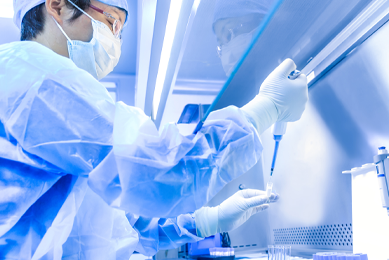The Adenovirus type 5 Reference Material (ARM) was developed in the early 2000s under the guidance of the Adenovirus Reference Material Working Group (ARMWG) to validate adenovirus infectious titer and particle concentration methods internally and externally and to provide a fixed reference point to allow comparison of different assay methods. The ARM was produced through the donation of services and supplies by a large number of laboratories and organizations from the United States, Canada, France, the Netherlands, Germany, and the United Kingdom. The working virus bank (ATCC VR-1516) was produced in a GMP HEK-293 working cell bank from the adenovirus master virus bank (MVB), which was made from plaque-purified Human adenovirus (ATCC VR-5). The working virus bank (ATCC VR-1516) was put through rigorous testing by multiple laboratories to ensure that the reported values were consistent and indicative of a reference material.
In the subsequent twenty years, ATCC VR-1516 has been written into FDA Guidance for Industry: Potency Tests for Cellular and Gene Therapy Products and has been distributed to laboratories around the world. However, when the initial bank was depleted in 2021, the ARMWG collaborators were not able to donate for a replenishment batch. With its nearly 100 years of culturing and repository experience, ATCC has partnered with NIST to manage ATCC VR-1516 into the future.
The new lot of ATCC VR-1516 was produced in a Univercells Technologies scale-X™[hydro] bioreactor. The HEK-293 working cell bank was expanded in flasks and then approximately 1.0 × 109 cells were seeded in the bioreactor. After four days, a vial of the original MVB was used for infection. The bioreactor monitors oxygen, pH, and carbon dioxide, and the decision to harvest is based on those measurements. Cells were lysed, media was collected, and the material was subjected to tangential flow filtration (TFF) using a modified polyethersulfone (mPES) membrane with a 300 kDa molecular weight cut-off. The material collected from the TFF was further purified using an anion exchange column. The eluate from the column was subjected to a second round of TFF (same membrane and molecular weight cut-off) to complete a buffer exchange into the final formulation buffer (20 mM TRIS, 25 mM NaCl, 2.5% glycerol, pH 8.0). The final material was vialed into cryovials.
The new lot of ATCC VR-1516 was quality control tested according to the previous lots' testing parameters and also tested using some newer methods. A vial of lot 001056 was tested alongside the new material to ensure that the new lot was equivalent to the original ARMWG material. Particle concentration was determined using a modified method that provided more consistent results.1 Replicates of each lot were performed, and both displayed consistent particle counts. The infectious titer was determined following the previous procedure with Normalized Adjusted Standard (NAS) Infectious Units/mL (NIU/mL) on HEK-293 cells. Both new and old lots were completed with 12 replicates and 14 dilutions. Infectious titer was also determined for both lots using the Tissue Culture Infectious Dose (TCID50) assay. Sequencing and analyses were performed on both lots using the Illumina® MiSeq™. The sequences from both lots were identical and showed no nucleotide variation greater than 10%. The new lot was tested for sterility; the presence of mycoplasma, human, mouse, and rat adventitious agents (IDEXX); and endotoxin. In addition to the variant analysis and titer methods described above, additional testing that was not done in 2002 includes droplet digital™ PCR (ddPCR™) to determine genome copy number, ddPCR™ to determine residuals, and NGS for adventitious agent analysis.
To learn more about the ARM and for more details on the difference between the ARMWG and ATCC lots, please visit our Viral Reference Materials and Human Adenovirus Type 5 Reference Material Comparison pages, respectively.
Did you know?
ATCC offers a variety of products that support cell and gene therapy development, including viral reference materials, CAR-T target luciferase reporter cells, and cell lines for enhanced virus production.
Meet the author
Heather Couch, PhD, PMP
Program Manager II, ATCC Federal Solutions
Dr. Couch is a Program Manager II at ATCC with management experience on several ATCC programs supporting the CDC, FDA, UNICEF, and NIAID contracts. These programs focus on global health and advancing diagnostics, vaccines, and therapeutics for infectious diseases. She has over ten years of project management, government contract management, partnership development, and evaluation of program priorities experience. She oversees all portfolio technical, cost, and schedule deliverables, including fiscal management, operations, QC, QA, regulatory compliance, biosafety, procurement, reporting, and subcontractor activities. Dr. Couch oversees a staff of approximately 40 scientists, project managers, and technical managers who support specific program deliverables. She maintains a high level of communication with funding agencies and outside advisors to establish and achieve project objectives and goals.
Explore our related resources

Viral Reference Materials
ATCC offers scientists viral reference materials for gene therapy research. Adeno-associated virus (AAV) reference standard materials are used as a benchmark for calibrating internal product-specific reference materials. (227)
More
Adenovirus Type 5 Reference Material New Lots
All new stocks of the Adenovirus type 5 reference material will be produced and authenticated at ATCC instead of by an outside working group. Here, we provide a culture comparison of the new and old stocks.
MoreStandards and Controls
Support your testing and assay development needs with high quality reference materials and national consensus standards from ATCC.
More